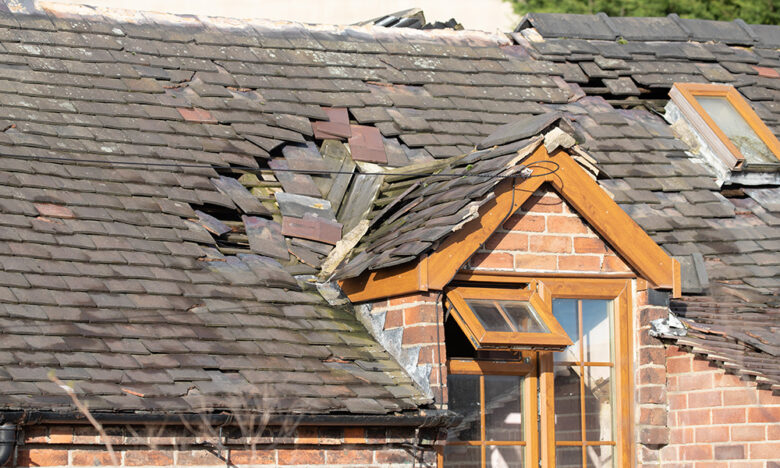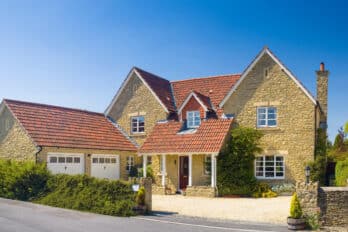
How to Check Your Roof for Storm Damage
As a series of storms pass over the UK, weather events which are expected to become more common, it’s essential to know how to check key parts of your home to see if they’re damaged. While fallen trees and garden debris will be easy to spot, assessing any damage to your roof can be more difficult. Knowing how to check your roof, what signs of damage to look for and how to rectify any issues is essential.
Firstly, be sure to wait until the storm has passed before venturing out to look at any damage. Once it’s safe, visually inspect from the ground. Look for damage to guttering, torn or missing roof tiles and debris on the basis that may have come from the roof. Also, take a look inside and see if there are any signs of water damage or leaks. Don’t forget to check in the loft if you have one, too, as this will likely be one of the first areas to show signs of damage.
If you do see any signs of damage or if you’re still uncertain about the integrity of your roof, it’s time to arrange for a professional roof survey. This will give you an accurate insight into the true state of your roof; drones and pole cams can be used to reach those hard to access areas, and elements such as chimneys and guttering will be thoroughly checked and any damage recorded.
Assessing Different Types of Roof Damage
Your roof is made up of several different elements, all of which need to be in good condition to ensure you have a safe, stable structure. Key issues to look out for include:
Missing or Loose Roof Tiles
This is one of the most common forms of damage from storms. roof tiles play an essential role in making sure your property is protected from the elements, so if any come loose, they must be fixed quickly to avoid causing further damage such as water getting into the property. Though it can be difficult to spot this from the ground, a roof survey will help if you suspect a problem.
Visible Cracks in The Roof
If left unattended, cracks can cause serious issues such as leaks, damage to insulation and the like, so rectifying it should be done as soon as possible. For minor cracks, it should be a relatively quick fix.
Debris in Your Guttering System
Clean and clear guttering is essential to the health of your home, so check for debris regularly, not just after storms. If you see shards of tile or roof tiles, it’s a sign of further damage to the roof. Flush any other debris away with a hose; this will also give you the chance to check that water is flowing freely and the downpipe isn’t clogged too.
Signs of Water Damage on the Inside of Your Home
Once you’ve assessed all you can externally, there are also signs to look for inside the house, particularly related to water damage. Specifically, look for wet patches on the ceiling, water stains on walls and mould or mildew. These are signs that water is getting in where it shouldn’t be.
Flat Roofs
Flat roofs can also suffer during storms, particularly as they lack drainage and can experience more debris build-up than traditional roofs. If it is safe to carry out a basic inspection yourself, there are a few things to look out for. If you find pools of water on the roof, you may have an issue with drainage, seals may become compromised, and gaps can appear in seams that can let water through. There could also be puncture damage or cracks in the roof that will require attention.
Chimney Repairs
Chimney damage is also typical during storms – as it’s the highest element of a house, it can be more exposed to high winds, heavy rain, hail and even lightning. More minor problems such as a missing chimney cap, cracked bricks or loose flashing can be easily rectified but can cause more damage if not fixed quickly. Again, leaks are the biggest risk, but the chimney itself could become unstable if left for long enough. Fortunately, you can make checks after a storm that don’t involve having to scale the chimney. For example, look for watermarks around your fireplace; check if the chimney cap has been dislodged; and look for cracks in the masonry or chips of masonry on the ground near the chimney.
Take the Right Action After Storm Damage
As soon as you know or suspect damage after a storm, it’s time to call in the professionals. Roofs can be notoriously expensive to fix, and as you may not be able to see what the damage is, it’s difficult to know if you’re paying the right amount for the right job. In addition, insurers are often not eager to pay for claims and if you’re a leaseholder convincing a freeholder to rectify issues can be a challenge. Before you call in roofing contractors and start getting quotes, your first step should always be to arrange for a roof survey, so you have all the information you need to get the problems fixed properly and fairly. Read more about getting your freeholder to repair a roof here.
Organise a RICS qualified roof survey
A roof survey carried out by specialist RICS qualified surveyors not only helps you to understand the actual condition of your roof and its components, but it will also tell you how much it should cost to repair. Whether you’re a leaseholder or a freeholder, this information is invaluable. If you’re asking roofing companies for quotes, you know exactly what the problem is and how much it should cost to fix, so you can be sure you’re only paying what you should. The survey report will also highlight the cause of the damage, which will be critical information if you claim your insurance. If the report confirms a storm caused the issues rather than gradual wear and tear, your insurer will have to payout.
As a leaseholder, if you deliver a clear, impartial report on the state of your roof and any issues that need to be fixed, your freeholder cannot ignore their obligation to ensure your property is safe and in good condition.
Whatever your situation, a specialist roof survey will put you in the best possible position to get your roof back in peak condition as quickly as possible.
The Novello Approach
At Novello, our roof surveys are carried out by a former roofing contractor who truly understands every aspect of a roof and its components. Whether you choose a standard roof survey or a drone roof survey, you can be sure you’ll receive specialist insight into the condition of your roof from RICS qualified chartered surveyors, and we always operate promptly so you can get on with the important business of getting your roof fixed.
Our standard roof surveys utilise PoleCams so we can access those hard to reach areas to ensure you get a thorough, accurate and impartial report that you can take to your insurers, freeholder or contractors. Our drone roof surveys avoid the need to erect scaffolding or have people working at height, so they’re safe, cost-effective and efficient. Our RICS qualified surveyors will fly compact, lightweight drones right up to the areas that need inspecting and take real-time, ultra-clear 4K videos and high-resolution photos to show exactly what work needs to be done. This enables us to access narrow spaces and hard to reach areas to give you the most accurate report possible.
Contact us today or get an Quotation now to find out more about either of our roof surveys.

